MACAU : Where Churches and Casinos Collide (Day 1)
This is the first day of a three-day trip to Macau (one-hour ferry ride from Hong Kong).
All attractions were free at the time of visit unless otherwise mentioned. All prices mentioned are in Macau Patacas.
This is Macau. The Macau where new casinos, resorts, and attractions are opening at an alarming rate. Built on reclaimed land, it looks as though Macau were a paradise for gamblers floating on the sea (I wonder what would become of Macau when the water level rises due to climate change.). Below is the Sands Casino (opened 2004) and the Fisherman's Wharf (opened 2005), a resort which brings together architecture from around the world.
Not wanting to linger around the ferry terminal for too much time, I began to head to my first destination--Fortaleza da Guia (Guia Fortress). But first, I had to find the bus.
After walking around and asking the locals for directions, I finally found the bus I needed. I confirmed with the bus driver whether the bus would stop by the Teleferico da Guia (Guia Cable Car). The bus driver told me it was my stop (after a three minutes or so) and that the Guia Cable Car was just around the corner (it was literally 10 steps away). Thinking back, I guess with all that time looking for the bus, I could have easily walked there from the ferry terminal.
It seemed like a quiet day. There were only a few others taking the cable car to Guia Hill. Perhaps it is the scorching heat or maybe it is just because it was a Tuesday. After a quick and cheap ($2) ride, I arrived at the top, with some relief to see greenery and much needed shade. I bought a bottle of ice cold water, wiped off my sweat (it was bloody hot) and continued walking towards the main attraction--Guia Fortress.
On the way there, my attention was caught by a large cannon placed outside of the Air Raid Shelter Showroom. Built right into the hill, the narrow passageways was a sign of Guia Hill's military importance in Macau's past. Today, it is probably more of a relief from the summer heat and humidity outside.
Guia Fortress
Finally! I have arrived after a what was seemingly a long trek from the ferry terminal. The air seemed to be fresher and the noise of the busy city below had faded away. Traffic below looked like a trail of ants. The Guia Lighthouse and the Chapel of Our Lady of Guia is just absolutely beautiful. The fortress is relaxing and clears the mind of all tensions (temporarily at least). It felt as though I was in Southern Europe! I'll let the pictures below do the explanation.
For some reason, the site became blurry, as if the fog was rolling in from the seas (some kind of show put on for tourists?!). Apparently, the gardeners were spraying insect repellent all over Guia Hill and so, very unfortunately, my tour of the fortress had to be cut short. We were advised to leave the hill as quickly as possible, and, we literally ran down the hill with a plume of white cloud haunting after us.
Exhausted, I began to look for the place that I had looked up for some dessert. I stopped at an intersection not knowing which way to go because the map that I had was poorly drawn. And it did take me a while before I realised, so I just kept on walking. But I guess I was lucky in a way because the store opened (for me) two minutes after I arrived at the shopfront of Lai Kei. I had an ice cream sandwich (chocolate, vanilla, melon squished together by a waffle biscuit on both sides; Sorvete de Sandwhich) and a red bean dessert in milk with ice (Feijao encarnado), all for $15.
Exhausted, I began to look for the place that I had looked up for some dessert. I stopped at an intersection not knowing which way to go because the map that I had was poorly drawn. And it did take me a while before I realised, so I just kept on walking. But I guess I was lucky in a way because the store opened (for me) two minutes after I arrived at the shopfront of Lai Kei. I had an ice cream sandwich (chocolate, vanilla, melon squished together by a waffle biscuit on both sides; Sorvete de Sandwhich) and a red bean dessert in milk with ice (Feijao encarnado), all for $15.
Afterwards, I began wandering up and down Avenida do Conselheiro Ferreiro de Almeida (What a mouthful!). Engine noise from motorcycles persistently shocked my ears as their drivers (with their companions clutching onto their waists) drove down this one-way arterial street.
I walked about two blocks in from the main road and came to the grounds of São Lázaro (St. Lazarus). The grounds were empty, the streets just outside of the gates were empty too, except one lady talking on her cell phone under a tree. This place was surely quiet since it is not a major tourist attraction, but where were all the locals? Even though it was not a Sunday, there should at least be some people around. Anyway, I let myself not become over-concerned and continued on.
I looked across from São Lázaro and found a building, apparently restored only recently to its colonial beauty. But when I looked behind the building and into the street, I saw a seemingly endless row of deteriorated apartments with cars and motorcycles all neatly parked onto the right side of the narrow street.
Afterwards, I headed back out onto Avenida do Conselheiro Ferreiro de Almeida where I began walking south towards Rua do Campo and Avenida da Praia Grande, the city's commercial district. The architecture of skyscrapers in this district did not surprise me from a distance, but when I began walking past its entrances, I noticed that the bases of these modern skyscrapers were (or were intentionally made to look like) colonial structures.
Afterwards, I headed back out onto Avenida do Conselheiro Ferreiro de Almeida where I began walking south towards Rua do Campo and Avenida da Praia Grande, the city's commercial district. The architecture of skyscrapers in this district did not surprise me from a distance, but when I began walking past its entrances, I noticed that the bases of these modern skyscrapers were (or were intentionally made to look like) colonial structures.
Before I got too excited over the city of Macau, which was to be my main destination for the second day, I realized that I should begin heading over to check-in at the hostel (and drop off my heavy bags). Though the hostel was quite a distance from where I was, I remained local and stuck with the bus. Buses to Coloane (the farthest island) were the most infrequent and most expensive in Macau but still, it was a mere 15 minute wait and cost only $5 for the entire trip (a taxi ride is said to cost about $60-$70).
Pousada de Juventude de Hac-Sa, the hostel that I stayed at, was located at a bus stop just one before the terminus at Hac-Sa Beach (literally Black Sand Beach famous for its...black sand!).
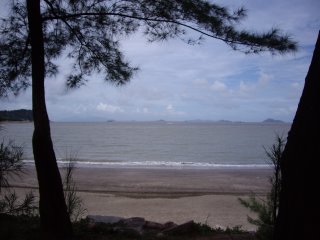
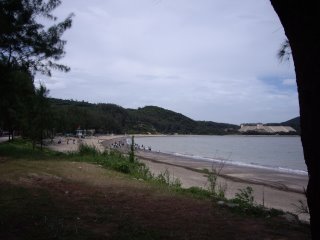
Dropping my bags off in my room, I headed up the highest point on Coloane (Alto de Coloane) where the A-Ma Cultural Village (including the Tin Hau Palace) and the Statue of A-Ma are located. The view from the Statue offers excellent view back onto Hac-Sa Beach, Taipa Island, and Cotai--the enormous area of land reclaimed between Coloane and Taipa.
Heading back down to the main road, I decided to stop by Coloane Village for an easy evening stroll. I picked up a few goodies from the bakery by the roundabout garden and walked along the shore (with China on the opposite shore).
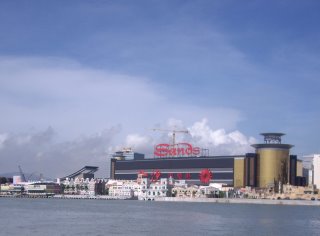
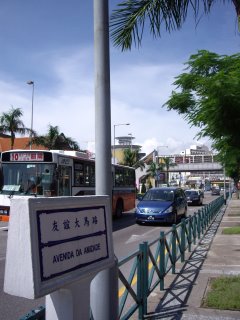

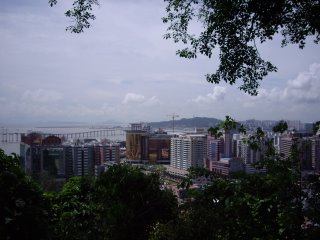
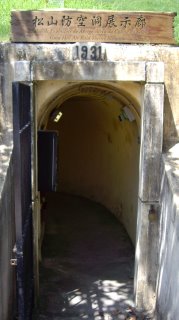

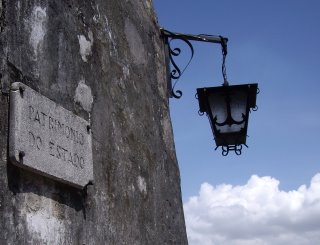

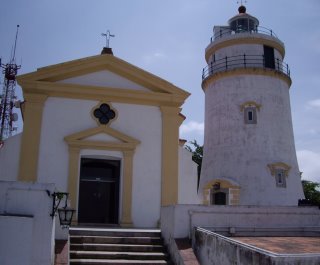
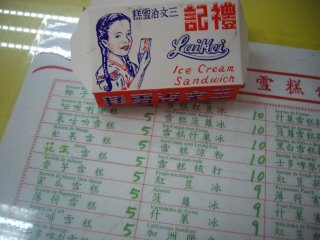
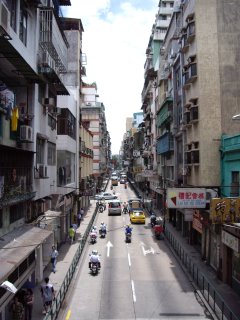
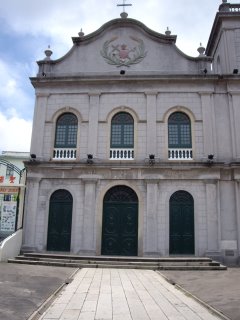
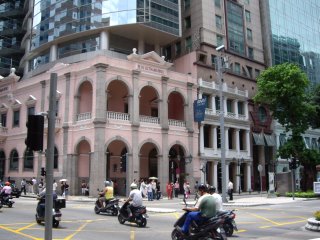


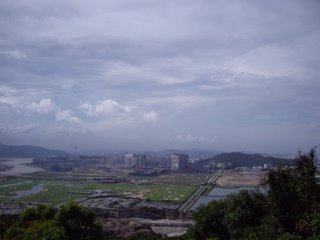

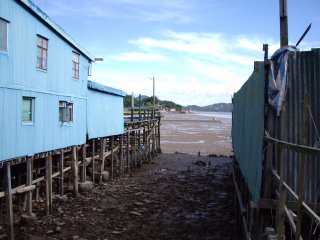


1 comment:
how come your pictures always look so professional? like photos taken specially for travel mags or whatevs...i'm sooo jealous. heh...anticipating your cool china pics soon =)
Post a Comment